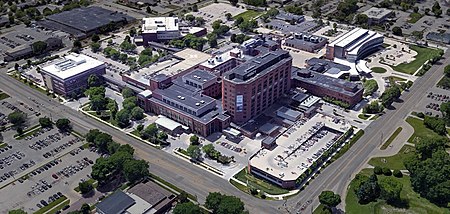Mercy Medical Center (Cedar Rapids, Iowa)
1900 establishments in IowaBuildings and structures in Cedar Rapids, IowaCatholic hospitals in North AmericaHospital buildings completed in 1903Hospitals established in 1900 ... and 1 more
Hospitals in Iowa

Mercy Medical Center is a Catholic hospital in Cedar Rapids, Iowa. The smaller of two metro hospitals, Mercy frequently ranks as either the best in Iowa or one of the top three. Mercy is a non-profit, acute-care medical center with a level III trauma center. Mercy Cedar Rapids is independent and not directly associated with other Mercy hospitals across the state and country. In addition to the non-profit hospital and clinics, Mercy operates outpatient and urgent-care clinics in a for-profit partnership with MercyCare Community Physicians.
Excerpt from the Wikipedia article Mercy Medical Center (Cedar Rapids, Iowa) (License: CC BY-SA 3.0, Authors, Images).Mercy Medical Center (Cedar Rapids, Iowa)
10th Street Northeast, Cedar Rapids
Geographical coordinates (GPS) Address Phone number Website External links Nearby Places Show on map
Geographical coordinates (GPS)
| Latitude | Longitude |
|---|---|
| N 41.978 ° | E -91.656 ° |
Address
Mercy Medical Center
10th Street Northeast 701
52403 Cedar Rapids
Iowa, United States
Open on Google Maps









